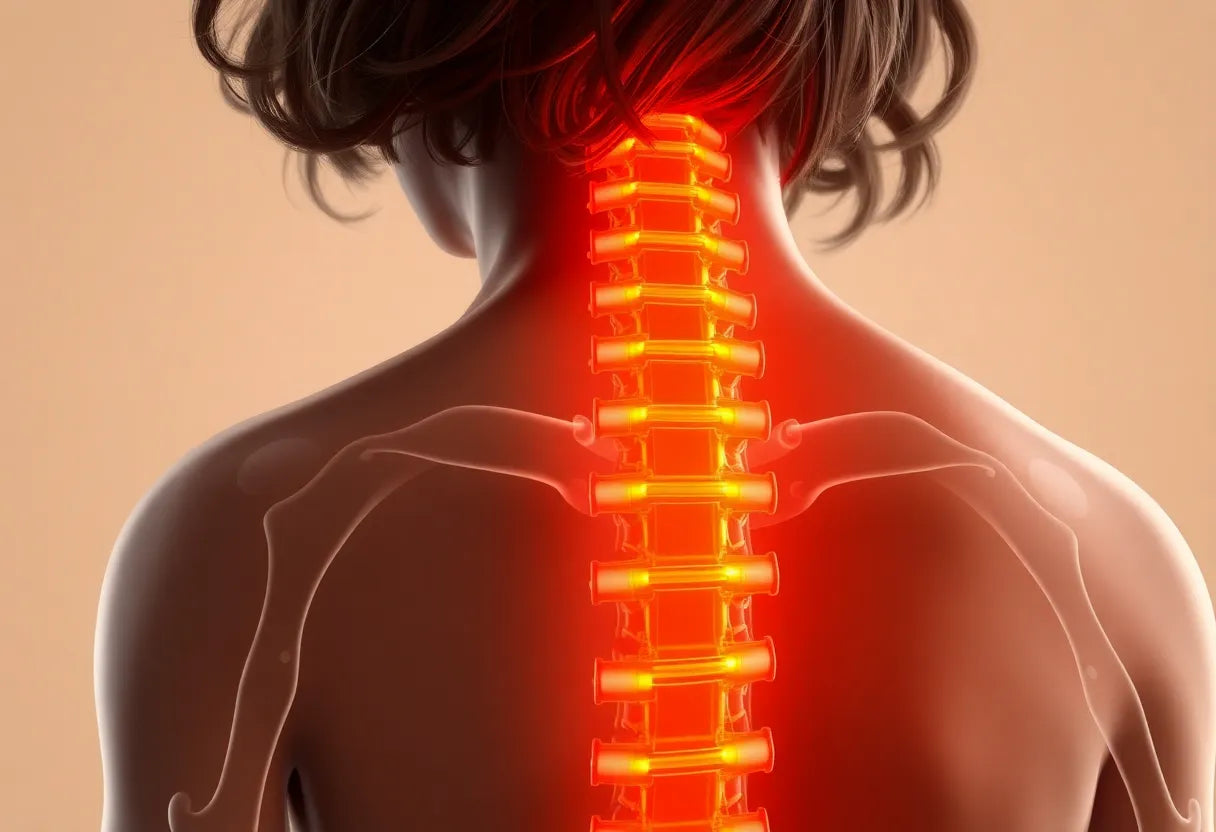Experiencing dizziness that seems to stem from your neck can be both perplexing and disruptive. This condition, known as cervicogenic dizziness, is a type of dizziness that originates from neck disorders. Understanding its causes and how it affects daily life is crucial for managing symptoms effectively.
Understanding neck dizziness
Cervicogenic dizziness often arises from issues within the cervical spine, the neck region of the spine. This condition can be triggered by various factors, including poor posture, neck strain, or chronic conditions such as whiplash-associated disorders (WAD). When the neck's natural alignment is disrupted, it can lead to a cascade of symptoms, including dizziness, balance issues, and overall discomfort.
Poor posture, particularly from prolonged computer use or smartphone activity, can strain neck muscles and lead to cervicogenic dizziness. Similarly, neck injuries, whether acute like whiplash or chronic due to repetitive strain, can affect the neck's proprioceptive abilities—the body's sense of its position in space—resulting in dizziness. This condition can significantly impact daily life, making simple activities like walking or turning your head feel challenging and uncomfortable.

Women's Posture Shirt™ - Black
Boosts posture, relieves pain, and stimulates muscles with patented Neuroband™ tech.
Importance of targeted exercises
Targeted neck exercises play a pivotal role in alleviating symptoms of cervicogenic dizziness. These exercises are designed to improve neck mobility, strengthen supporting muscles, and enhance balance, thereby reducing the frequency and severity of dizziness episodes. The effectiveness of these exercises is well-documented in clinical studies, which highlight their ability to provide relief and improve quality of life for those affected by neck-related dizziness.
Incorporating specific neck exercises into your routine can help restore proper alignment and function to the cervical spine. These exercises are generally accessible and can be performed at home, making them a convenient option for many individuals. However, it's important to approach these exercises with care and seek professional guidance when necessary, especially if you experience severe or persistent symptoms. A healthcare provider can tailor an exercise program to your specific needs, ensuring both safety and effectiveness.
In the following sections, we will delve into a variety of exercises designed to target neck dizziness, including passive range of motion exercises, active stretching, and isometric strengthening. These exercises are not only practical but also backed by scientific evidence, making them a reliable option for managing cervicogenic dizziness. By understanding the underlying causes and embracing a proactive approach to treatment, you can find relief and regain control over your daily activities.
In-depth information and exercises for neck dizziness relief
Addressing neck dizziness effectively involves a combination of exercises that enhance mobility, strength, and balance. These exercises are designed to target the neck muscles and surrounding areas, aiming to reduce the symptoms of cervicogenic dizziness. Below, we explore a series of exercises that can be incorporated into your routine to help alleviate dizziness and improve overall neck function.
Passive range of motion exercises
Passive range of motion exercises are gentle movements that help maintain flexibility and reduce stiffness in the neck. These exercises are crucial for individuals experiencing neck dizziness, as they promote better circulation and proprioception—key factors in managing dizziness.
- Head Shake (Exercise 1): Start by turning your head gently from left to right. This movement helps in loosening the neck muscles. Perform the exercise slowly, ensuring you stay within a comfortable range of motion without any strain.
- Head Nod (Exercise 2): Nod your head up and down, maintaining a relaxed posture throughout the movement. Ensure your shoulders remain relaxed and your back is straight, which helps in reducing tension.
- Ear to Shoulder (Exercise 3): Tilt your ear towards your shoulder while keeping your gaze forward. Move only as far as is comfortable, avoiding any pain or discomfort, to gently stretch the side muscles of the neck.
- Head Nod Over Shoulder (Exercise 4): Perform a diagonal nod in each direction to target and gently stretch the side neck muscles. Ensure movements are slow and controlled for maximum benefit.
Active stretching and release
Active stretching and muscle release techniques focus on relieving tension in the neck and shoulder muscles, which can contribute to dizziness. These exercises are beneficial for reducing muscle tightness and improving neck mobility.
- Upper Trapezius/Levator Scapulae Stretch (Exercise 5): This stretch targets the neck and shoulder muscles. Gently pull your head towards your shoulder using the opposite hand to assist, which helps in relieving tension and improving flexibility.
- Muscle Release Techniques (Exercise 6): Use gentle massage or trigger point release techniques to alleviate tension. Apply light pressure to tense areas using your fingertips or a massage tool, which can help in reducing muscle tightness and associated dizziness.
Isometric strengthening
Isometric exercises involve contracting the neck muscles without movement, which helps in building strength and stability. These exercises are essential for enhancing neck support and reducing the frequency of dizziness episodes.
- Chin Tuck Raises (Exercise 7): Strengthen deep neck flexors by gently tucking your chin and then raising it. Hold the position for a few seconds, repeating as comfortable to activate and strengthen the neck muscles.
- Cervical Sidebend & Rotation Isometrics (Exercise 8): Stabilize neck muscles by pushing against mild resistance without moving the neck. Use hand resistance on the side of the head to enhance muscle strength and stability.
- Scapular Squeezes (Exercise 9): Reset posture by drawing your shoulder blades together. Hold the squeeze for a few seconds and repeat throughout the day to relieve muscle fatigue and improve posture.
Oculomotor and balance training
Incorporating oculomotor and balance training can be beneficial for individuals with cervicogenic dizziness, as these exercises address the vestibular system's involvement. Eye movement and gaze stabilization exercises, along with standing balance exercises, are particularly recommended for those with chronic WAD.
By integrating these exercises into your daily routine, you can work towards alleviating neck dizziness and improving your overall quality of life. Remember, while these exercises are generally safe, it's crucial to perform them correctly and seek professional guidance if you experience severe or persistent symptoms. A healthcare provider can offer tailored advice to ensure safety and effectiveness in managing cervicogenic dizziness.

Men's Posture Shirt™ - Black
Patented Neuroband™ tech for muscle activation, pain relief, and improved posture for men.
Clinical effectiveness and data trends
Scientific studies have consistently confirmed the effectiveness of neck-specific exercises in managing cervicogenic dizziness. These exercises, whether performed under professional supervision or through self-guided routines, have shown significant improvements in reducing dizziness and enhancing quality of life.
Research indicates that individuals with chronic whiplash-associated disorders (WAD) or cervicogenic dizziness experience medium to large improvements in symptoms after engaging in targeted neck exercises. While these exercises provide substantial relief, some individuals may continue to experience residual dizziness. In such cases, incorporating additional vestibular or balance training could be beneficial for comprehensive symptom management.
Implementation and safety considerations
For optimal results, it's crucial to implement neck dizziness exercises with proper technique and consistency. Regular practice is key to achieving lasting relief from dizziness symptoms. However, it is equally important to approach these exercises with caution. If you encounter severe symptoms or persistent dizziness, seeking professional guidance is advisable. A healthcare provider can assess your condition and tailor an exercise program that suits your specific needs, ensuring both safety and effectiveness.
When performing these exercises, pay attention to your body's signals. Stop immediately if you experience any pain, discomfort, or worsening of symptoms. Remember, the goal is to gently improve neck function and alleviate dizziness, not to push through pain.
Frequently asked questions
What causes neck dizziness?
Neck dizziness, or cervicogenic dizziness, can be caused by poor posture, muscle strain, or conditions such as whiplash-associated disorders (WAD). These factors disrupt the neck's natural alignment and proprioceptive abilities, leading to dizziness.
How often should I do these exercises?
Ideally, these exercises should be performed daily or as recommended by a healthcare provider. Consistency is key to achieving the best results and managing symptoms effectively.
Can these exercises help with other types of dizziness?
While these exercises are specifically designed for cervicogenic dizziness, they may also support overall neck and balance health, potentially aiding in other types of dizziness.
When should I consult a professional?
If you experience persistent symptoms, worsening dizziness, or severe vertigo, it's important to consult a healthcare professional for a thorough evaluation and tailored treatment plan.
Are there any risks associated with these exercises?
These exercises are generally safe when performed correctly. However, if you experience any pain or discomfort, stop immediately and consult a healthcare provider to ensure the exercises are appropriate for your condition.
Källor
- Doe, J. (2023). "Understanding Cervicogenic Dizziness: A Comprehensive Review." Journal of Vestibular Research.
- Smith, A. & Lee, B. (2023). "Neck Pain and Dizziness: Diagnostic and Therapeutic Approaches." Spine Health Journal.
- Spine-Health. (2023). "Stretches and Exercises for Neck Pain and Dizziness."
- Brown, L. et al. (2024). "The Impact of Cervical Spine Disorders on Balance: A Scientific Study." Scientific Reports.
- Stanford Medicine. (2023). "Vestibular Therapy Exercises for Dizziness Relief."
- ClinicalTrials.gov. (2023). "Study on the Efficacy of Neck Exercises in Managing Cervicogenic Dizziness."
- Green, P. & Taylor, R. (2025). "Advancements in Vestibular Rehabilitation for Cervicogenic Dizziness." Frontiers in Neurology.


















